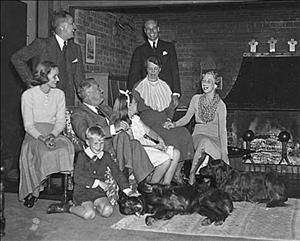On October 1, 1937, President Franklin D. Roosevelt (1882-1945) tours the Olympic Peninsula loop from Lake Crescent in Clallam County through Jefferson County to Lake Quinault and the cities of Aberdeen and Hoquiam in Grays Harbor County. Along the way he views demonstrations of fire fighting and tree topping, lunches at the Lake Quinault Inn, and hears arguments for and against the proposed national park on the peninsula. Roosevelt announces support for a park, which is created nine months later.
The presidential party reached the peninsula on September 30, 1937, arriving at Port Angeles, Clallam County, following a visit to Victoria, British Columbia. The large crowd that greeted Roosevelt in Port Angeles included hundreds of school children standing under a sign that read "Mr. President, these children want Olympus National Park" (Seattle P-I, October 1, 1937). The president responded by assuring the crowd that there would be a park, his first definite commitment to the proposal.
The party spent the night at Lake Crescent, where Roosevelt discussed the park proposal around his cottage fireside with state and federal officials. Rep. Mon Wallgren of Everett, who had introduced a bill to create the park, and park service superintendent O. A. Tomlinson advocated for a large park. Rep. Martin Smith of Hoquiam and regional forester C. J. Buck urged leaving more forest available for timber production. The debate continued the next day as the officials joined the presidential motorcade, which also included Roosevelt’s son and several grandchildren, and local and national reporters.
A Rainy Tour
Although clouds and driving rain obscured views of the peninsula’s mountains, ocean, and forests for most of the day on October 1, 1937, the president went ahead with the Olympic loop tour. Near Lake Crescent, he and his party viewed a reforestation project where Civilian Conservation Corps (CCC) workers had planted 2 million trees. At the Snyder ranger station they saw a fire fighting demonstration that included trains of pack horses loaded with firefighting equipment. Outside Forks, "ace topper" Fred Wilson demonstrated tree topping for the president, practically running up a 250 foot Douglas fir to a point about 195 feet high, where he cut through a notch prepared earlier and brought the top down.
From Forks to the lunch stop at Lake Quinault, where the party was joined by Washington governor Clarence Martin and his son Frank, the road ran largely through untouched forest (much of it logged in subsequent years). From the lake south to Aberdeen and Hoquiam, however, as the sun started to emerge from clouds, the road ran through miles of raw and ugly clear cuts. According to historian Murray Morgan (1916-2000), then a young reporter on the peninsula, at one point Roosevelt said to the Congressmen, "I hope the son-of-a-bitch who logged that is roasting in hell" (Morgan, 185).
By mid-afternoon, the motorcade reached Hoquiam and Aberdeen, where crowds of more than 50,000 lined the streets, and Roosevelt stopped briefly to speak to them. The motorcade also made stops in the Grays Harbor County communities of Montesano, Elma, and McCleary, before continuing on to Olympia. By the end of the tour, Roosevelt had made clear his support for a large national park on the Olympic Peninsula. Nine months later he signed legislation creating Olympic National Park.

